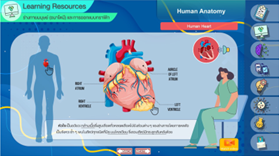การออกแบบและพัฒนาโมเดลสิ่งแวดล้อมการเรียนรู้ตามแนวคอนสตรัคติวิสต์ที่ส่งเสริมการคิดสร้างสรรค์และการแสดงออกอย่างสร้างสรรค์ทางวิทยาศาสตร์ สำหรับการออกแบบกราฟิกทางการแพทย์
Main Article Content
บทคัดย่อ
การวิจัยครั้งนี้ มีวัตถุประสงค์เพื่อออกแบบและพัฒนาโมเดลสิ่งแวดล้อมการเรียนรู้ตามแนวคอนสตรัคติวิสต์ที่ส่งเสริมการคิดสร้างสรรค์และการแสดงออกอย่างสร้างสรรค์ทางวิทยาศาสตร์ รายวิชาการออกแบบกราฟิกทางการแพทย์ โดยใช้รูปแบบการวิจัยคือ การวิจัยโมเดล (model research) ในระยะที่ 1 การพัฒนาโมเดล (model development) ซึ่งประกอบไปด้วย การวิจัยเอกสาร (document analysis) และการวิจัยเชิงสำรวจ (survey research) มีกลุ่มเป้าหมายคือ ผู้เชี่ยวชาญตรวจสอบคุณภาพของโมเดลฯ จำนวน 3 คน ผู้เชี่ยวชาญด้านวัดและประเมินจำนวน 3 คน ผู้ออกแบบโมเดลฯ จำนวน 1 คน ผู้พัฒนาโมเดลฯ จำนวน 1 คน ผู้สอนจำนวน 1 คน และ ผู้เรียนซึ่งเป็นนักศึกษาชั้นปีที่ 1 สาขาเวชนิทัศน์ คณะแพทยศาสตร์ มหาวิทยาลัยขอนแก่น จำนวน 30 คน
ผลการวิจัย พบว่า 1) กระบวนการออกแบบและพัฒนาโมเดลสิ่งแวดล้อมการเรียนรู้ฯ ได้แก่ การสังเคราะห์กรอบแนวคิดเชิงทฤษฎี การสังเคราะห์กรอบแนวคิดการออกแบบโมเดล แล้วนำมาพัฒนาเป็นสิ่งแวดล้อมการเรียนรู้ฯ ซึ่งได้จากการสังเคราะห์องค์ประกอบของโมเดล ได้เป็น 8 องค์ประกอบ คือ (1) สถานการณ์ปัญหา (2) แหล่งเรียนรู้ (3) เครื่องมือทางปัญญา (4) ศูนย์แลกเปลี่ยน (5) ศูนย์ส่งเสริมการคิดสร้างสรรค์ (6) ศูนย์ส่งเสริมการแสดงออกอย่างสร้างสรรค์ทางวิทยาศาสตร์ (7) ศูนย์ช่วยเหลือ และ (8) ศูนย์ให้คำแนะนำ และ 2) การประเมินคุณภาพของสิ่งแวดล้อมการเรียนรู้ฯจากผู้เชี่ยวชาญทั้ง 3 ด้านคือ ด้านเนื้อหา มีความถูกต้องและเหมาะสม ด้านสื่อ มีองค์ประกอบทางศิลปะช่วยส่งเสริมการเรียนรู้ได้ดี ผู้เรียนสามารถเข้าถึงสารสนเทศได้อย่างสะดวกรวดเร็ว และด้านการออกแบบโมเดลฯ มีองค์ประกอบที่สอดคล้องกับหลักการทฤษฎี สถานการณ์ปัญหาสามารถกระตุ้นให้ผู้เรียนเกิดความสงสัยได้ สามารถส่งเสริมให้ผู้เรียนเกิดการคิดสร้างสรรค์ และการแสดงออกอย่างสร้างสรรค์ทางวิทยาศาสตร์
Article Details

อนุญาตภายใต้เงื่อนไข Creative Commons Attribution-NonCommercial-NoDerivatives 4.0 International License.
เอกสารอ้างอิง
จารุณี ซามาตย์. (2559). การออกแบบและพัฒนาโมเดลสิ่งแวดล้อมการเรียนรู้ตามแนวคอนสตรัคติวิสต์เพื่อส่งเสริมการคิดสร้างสรรค์รายวิชา หลักการพื้นฐานสำหรับการพัฒนาซอฟต์แวร์ทางการศึกษา สำหรับนักศึกษาคอมพิวเตอร์ศึกษา. วารสารมหาวิทยาลัยราชภัฏมหาสารคาม (มนุษยศาสตร์และสังคมศาสตร์), 10(3), 56-59.
สุมาลี ชัยเจริญ. (2550). การพัฒนาโมเดลต้นแบบสิ่งแวดล้อมทางการเรียนรู้บนเครือข่าย ที่ส่งเสริมการสร้างความรู้ตามแนวคอนสตรัคติวิสต์. ขอนแก่น: คณะศึกษาศาสตร์ มหาวิทยาลัยขอนแก่น.
อิศรา ก้านจักร. (2552). การพัฒนาโมเดลสิ่งแวดล้อมการเรียนรู้ที่ส่งเสริมเมนทอลโมเดลแบบ ผู้เชี่ยวชาญ. วิทยานิพนธ์ปริญญาปรัชญาดุษฎีบัณฑิต สาขาวิชาเทคโนโลยีการศึกษา บัณฑิตวิทยาลัย มหาวิทยาลัยขอนแก่น.
Arntz, M., Gregory, T., Zierahn, U. (2016). The Risk of Automation for Jobs in OECD Countries: A Comparative Analysis. Paris: OECD.
Aubusson, P.J., Harrison, A.G. and Ritchie, S.M. (2006). Serious Thought in Science Education. Metaphor and Analogy in Science Education.
Bogard, T. Liu, M. and Chiang, Y.V. (2013). Thresholds of Knowledge Development in Complex Problem Solving: A Multiple-Case Study of Advanced Learners’cognitive Processes. Education Tech Research Dev., 61, 465–503.
Brown, S.A. (2015). Creative Expression of Science Through Poetry and Other Media can Enrich Medical and Science Education. Frontiers in Neurology, 6(2).
Chaijaroen, S., Kanjug, I., Samat, C. (2019). Learner’s Creative Thinking Learning with Constructivist Web-Based Learning Environment Model: Integration Between Pedagogy and Neuroscience. In: Rønningsbakk, L., Wu, TT., Sandnes, F., & Huang, YM. (eds). Innovative Technologies and Learning. ICITL 2019. Lecture Notes in Computer Science, 11937. Springer, Cham.
Collins, A., Brown, J.S. and Newman et al. (1989). Cognitive Apprenticeship: Teaching the Craft of Reading, Writing and Matematics. In L.B. Resnick (Ed.). Knowing, Learning and instruction: Essays in honor of Robert Glaser Hillsdale. (pp.55-70). New Jersey: Erlbaum.
Dillon, J.A. (2009). Play, Creativity, Emotion Regulation and Executive functioning. Master of Arts Department of Psychology, Case Western Reserve University.
Fink, A. and Grabner, R.H. et al. (2010). Enhancing Creativity by Means of Cognitive Stimulation: Evidence from an fMRI study. NeuroImage, 52, 1687-1695.
Fazelian, P. and Azimi, S. (2012). Creativity in Schools. Social and Behavioral Sciences, 82, 719 – 723.
Gregory, E. et al. (2013). Building Creative Thinking in The Classroom: From Research to Practice. International Journal of Educational Research, 62, 43–50.
Guilford, J.P. (1967). The Nature of Human Intelligence. New York: McGraw-Hill.
Hannafin, M.J. (1995). Open-Ended Learning Environments: Foundations, Assumptions, And Implications for Automated Design. In R. Tennyson (Ed.). Perspectives on Automating Instructional Design. (pp.101-129). New York: Springer-Verlag.
Hong, Y.Y. et al. (2000). Multicultural Minds: A Dynamic Constructivist Approach to Culture and Cognition. American Psychologist, 55, 709-720.
Jonassen, D.H., and Tessmer, M. (1996). An Outcomes-Based Taxonomy for Instructional Systems Design. Evaluation and Research.Training Research Journal, 2, 11- 46.
Jonassen, D.H. (1997). Instructional Design Model for Well-Structured and Ill-Structured Problem-Solving Learning Outcomes. Educational Technology. Research and Development, 45(1), 65-95.
Kuo, F.R., Chen, N.S., and Hwang, G.W. (2014). A Creative Thinking Approach to Enhancing the Web-Based Problem-Solving Performance of University Students. Computers & Education, 72 (2014), 220–230.
Kozma, R. (1991). Learning with Media. Review of Educational Research, 61(2), 179-212.
Mayer, R.E. (2001). Multimedia learning. New York: Cambridge University.
Mayer, R.E. (1997). Multimedia Learning: Are We Asking the Right Questions. Educational Psychologist, 32, 1-19.
Neo, M. (2005). Web-enhanced Learning: Engaging Students in Constructivist Learning. Campus-Wide Information Systems, 22(1), 4 – 14.
Puangtong, P. (2012). The Development of Web-Based Learning Environments Model to Enhance Cognitive Skills and Critical Thinking For Undergraduate Students. Procedia - Social and Behavioral Sciences, 46, 5900 – 5904.
Richey, R.C. and Klein, J. (2007). Design and Developmental Research. New Jersey: Lawrence. Rotherham, A.J. and Willingham, D. (2009). 21st Century Skills: The Challenges Ahead. Educational Leadership, 67(1), 16–21.
Sawyer, R.K., and Berson, S. (2004). Study group discourse: How external representations affect collaborative conversation. Linguistics and Education, 15(4), 387–412.
Semraakyol. (2010). Effects of social constructivist Learning Environment Design on 5th Grade Learners’ Learning. Procedia Social and Behavioral Sciences, 9, 948–953
Wang, S.K. and Reeve, T.C. (2006). The Effects of a Web-Based Learning Environment on Student Motivation in a High School Earth Science Course. Educational Technology Research and Development, 54(6), 597-621.
Yong, E. (2019). Colouring Your Mind – Red Improves Attention to Detail, Blue Boosts Creativity. Vancouver: University of British Columbia.
Zahidi, S., Ratcheva, V., Hingel, G., Brown, S. (2020). World Economic Forum Research Report: The Future of Jobs Report 2020. Switzerland: World Economic Forum.


